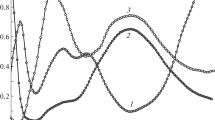Summary
The kinetics of dissociation of the ethylenedibiguanidenickel(II) and copper(II), [M(EndibigH2)]2+, where M = NiII or CuII, and bisbiguanide-nickel(II), [Ni(BigH)2]2+, complexes in acid media forming the aquo-metal ions and the protonated ligand as the ultimate products have been studied by the stopped-flow technique. The reactions occur in two consecutive steps, the first being faster than the second, forming aquometal ions and protonated ligands as the ultimate products. For each step the rate is acid dependent and may be expressed by: kx = k ′x [H+] + k ″x [H+]2, where kx is the observed rate constant and x = “f” or “s” for fast and slow steps respectively. Both paths (k ′x and k ″x ) contribute in the ethylenedibiguanidenickel(II) system, whereas k ′x paths are virtually absent in the corresponding copper(II) complex; k ″x paths are absent in the bisbiguanidenickel(II) system. A likely mechanism involves protonation of the bound ligand which facilitates its dissociation. A comparison of the ΔS≠ values indicates considerable solvent participation in the transition state, suggesting an assisted dissociative mechanism, which also accounts for the low ΔH≠ values. The observed lability order is [Ni(EndibigH2)]2+ < [Ni(BigH)2]2+ =ca. [Cu(EndibigH2)]2+, and [Cu(BigH)2]2+ dissociates under comparable conditions at a rate too fast to be measured by the stopped-flow method.
Similar content being viewed by others
References
P. Ray,Chem. Rev., 61, 313 (1961).
D. Banerjea and B. Chakravarty,J. Inorg. Nucl. Chem., 26, 1233 (1964).
D. Banerjea and S. Sengupta,Z. Anorg. Allg. Chem., 397, 215 (1973).
D. Banerjea and B. Chattopadhyay,J. Inorg. Nud. Chem., 36, 2351 (1974).
D. Banerjea and P. Banerjee,Z. Anorg. Allg. Chem., 393, 295 (1972).
D. Banerjea,Z. Anorg. Allg. Chem., 344, 72 (1966).
N. R. Kunchur and H. Mathew,Chem. Comm.,87 (1966).
T. C. Creitz, R. Gsell and D. C. Wampler,Chem. Comm., 1371 (1969).
R. N. Banerjee and D. Banerjea,Ind. J. Chem., 17A, 246 (1979).
D. Sen,J. Chem. Soc. A, 2900 (1969).
G. Schwarzenbach and D. Schwarzenbach,J. Ind. Chem. Soc., 54, 23 (1977).
C. D. Hodgman (Ed.),Handbook of Chemistry and Physics 37th Edn., pp. 1727 and 1735, The Chemical Rubber Publishing Co., Cleveland, Ohio, USA (1960).
D. J. MacDonald,J. Inorg. Nud. Chem., 29, 1271 (1967).
B. Das Sarma,J. Ind. Chem. Soc., 29, 217 (1952).
P. Ray and S. P. Ghosh,J. Ind. Chem. Soc., 20, 291 (1943).
P. Ray and P. N. Bagchi,J. Ind. Chem. Soc., 16, 617 (1939).
P. Ray and B. C. Purakayastha,J. Ind. Chem. Soc., 18, 217 (1941).
Author information
Authors and Affiliations
Rights and permissions
About this article
Cite this article
Banerjea, D. Kinetics and mechanism of dissociation of ethylenedibiguanidenickel(II) and copper(II) and of bisbiguanide-nickel(II) in acid. Transition Met Chem 7, 22–25 (1982). https://doi.org/10.1007/BF00623802
Received:
Issue Date:
DOI: https://doi.org/10.1007/BF00623802




